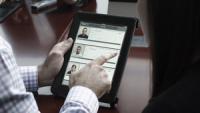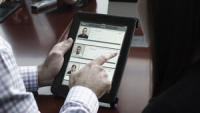-
Scientific basis of fingerprints too weak for legal certainty
It may surprise many, especially those susceptible to the CSI effect, but fingerprint evidence is not conclusive beyond a reasonable doubt. A new American Association for the Advancement of Science (AAAS) working group report on the quality of latent fingerprint analysis says that courtroom testimony and reports stating or even implying that fingerprints collected from a crime scene belong to a single person are indefensible and lack scientific foundation.
-
-
Touch-free fingerprint scanners
Balancing speed and security at the airport is essential to ensuring safe, reliable travel. DHS S&T and TSA are evaluating new identity verification technology that can reduce the time it takes for travelers to pass through security. The touch-free scanners allow a traveler’s fingerprints to serve as their boarding pass and identity document.
-
-
Rapid DNA technology verifies relationships after mass casualty events
Rapid DNA technology developed by DHS S&T has recently been used to identify simulated “victims” in several mass casualty exercises across the United States. The technology greatly expedites the testing of deoxyribonucleic acid (DNA), the only biometric that can accurately verify family relationships.
-
-
Germany testing face-recognition software to help police spot terrorists
Germany will be testing facial recognition software at a Berlin train station this summer to see whether it can assist police identify terror suspects more quickly. Volunteers will help police test the software at Berlin’s Suedkreuz station. If the test is successful, the use of the biometric software would be expanded to other locations, and also used to help police identify criminals, not only people suspected of terrorist activities.
-
-
New tool spots fake online profiles
People who use fake profiles online could be more easily identified, thanks to a new tool developed by computer scientists. Researchers have trained computer models to spot social media users who make up information about themselves — known as catfishes. The system is designed to identify users who are dishonest about their age or gender. Scientists believe it could have potential benefits for helping to ensure the safety of social networks.
-
-
Face Recognition Challenge seeks better face-identification software

Have you developed software to identity faces in general web photographs? Can your software verify that a face in one photograph is the same as in another? The Intelligence Advanced Research Projects Activity (IARPA) announced the launch of the Face Recognition Prize Challenge (FRPC). The challenge aims to improve biometric face recognition by improving core face recognition accuracy.
-
-
Thwarting forgery with paper fingerprints
Designing secure documents that provide high levels of security against forgery is a long-standing problem. Even in today’s digital age, this problem remains important as paper is still the most common form of proving authenticity – such as receipts, contracts, certificates and passports. Fingerprinting official documents could provide a cost-effective way to prevent forgery, new research shows.
-
-
Partial fingerprints sufficient to trick biometric security systems on smartphones
No two people are believed to have identical fingerprints, but researchers have found that partial similarities between prints are common enough that the fingerprint-based security systems used in mobile phones and other electronic devices can be more vulnerable than previously thought.
-
-
Aging affects the performance of automatic facial recognition systems

Images of our faces exist in numerous important databases – driver’s license, passport, law enforcement, employment – all to accurately identify us. But can these images continue to identify us as we age? Biometrics experts set out to investigate what extent facial aging affects the performance of automatic facial recognition systems and what implications it could have on successfully identifying criminals or determining when identification documents need to be renewed.
-
-
Legacy travel booking systems do not protect travelers’ private information
Travel bookings worldwide are maintained in a handful of systems. The three largest — Global Distributed Systems (GDS) Amadeus, Sabre, and Travelport — administer more than 90 percent of flight reservations as well as numerous hotel, car, and other travel bookings. The most important security feature lacking from all three GDSs is a proper way to authenticate travelers.
-
-
It is time to stop using bite marks in forensics: Experts
Forensic dentists claim that they can accurately associate a bite mark to the one and only set of teeth in the world that could have produced the crime scene bite mark. There is, however, no sound basis for believing that forensic dentists can do such a thing, and researchers are increasingly skeptical about the validity of bite-mark identification as trial evidence.
-
-
Germany's Migration Office failed to detect forged passports
Critics say that Germany’s Federal Migration Office (BAMF) has not resolved severe security flaws which resulted in officials failing to detect counterfeit passports used by refugees entering the country. The attorney general for the state of Brandenburg, Erado Rautenberg, is now seeking to seize around 18,000 records from BAMF. Fake passports were seized in the southern German state of Bavaria. What is troubling security agencies is the fact that the passports were previously determined to be legitimate by the asylum office. Some 3,300 more passports are also being reanalyzed in the north-eastern state of Mecklenburg-Western Pomerania.
-
-
The accuracy of the FBI’s face-recognition technology may be improved: GAO
The Department of Justice’s (DOJ) Federal Bureau of Investigation (FBI) operates the Next Generation Identification-Interstate Photo System (NGI-IPS) — a face recognition service that allows law enforcement agencies to search a database of over thirty million photos to support criminal investigations. The GAO examined the FBI’s face recognition capabilities, and the extent to which the FBI’s use of face recognition adhered to privacy laws and policies, and the accuracy of these capabilities.
-
-
Hair analysis is flawed as a forensic technique
Since 1989, seventy-four people who were convicted of serious crimes, in large part due to microscopic hair comparisons, were later exonerated by post-conviction DNA analysis. A new article highlights the statistical failings of microscopic hair analysis in criminal investigations, noting that more than twenty characteristics can be used to describe or identify a single hair, but many are subjective.
-
-
Texas’s E-Verify law operating under honor system
After former Gov. Rick Perry issued an executive order in December 2014 mandating the use of E-Verify for state agencies, some lawmakers noted the directive lacked a mechanism to ensure compliance. But more than nine months after Gov. Greg Abbott signed a separate E-Verify bill, some of those gaps still exist.
-
- All
- Regional
- Water
- Biometrics
- Borders/Immig
- Business
- Cybersecurity
- Detection
- Disasters
- Government
- Infrastructure
- International
- Public health
- Public Safety
- Communication interoperabillity
- Emergency services
- Emergency medical services
- Fire
- First response
- IEDs
- Law Enforcement
- Law Enforcement Technology
- Military technology
- Nonlethal weapons
- Nuclear weapons
- Personal protection equipment
- Police
- Notification /alert systems
- Situational awareness
- Weapons systems
- Sci-Tech
- Sector Reports
- Surveillance
- Transportation
Advertising & Marketing: advertise@newswirepubs.com
Editorial: editor@newswirepubs.com
General: info@newswirepubs.com
2010-2011 © News Wire Publications, LLC News Wire Publications, LLC
220 Old Country Road | Suite 200 | Mineola | New York | 11501
Permissions and Policies
Editorial: editor@newswirepubs.com
General: info@newswirepubs.com
2010-2011 © News Wire Publications, LLC News Wire Publications, LLC
220 Old Country Road | Suite 200 | Mineola | New York | 11501
Permissions and Policies
